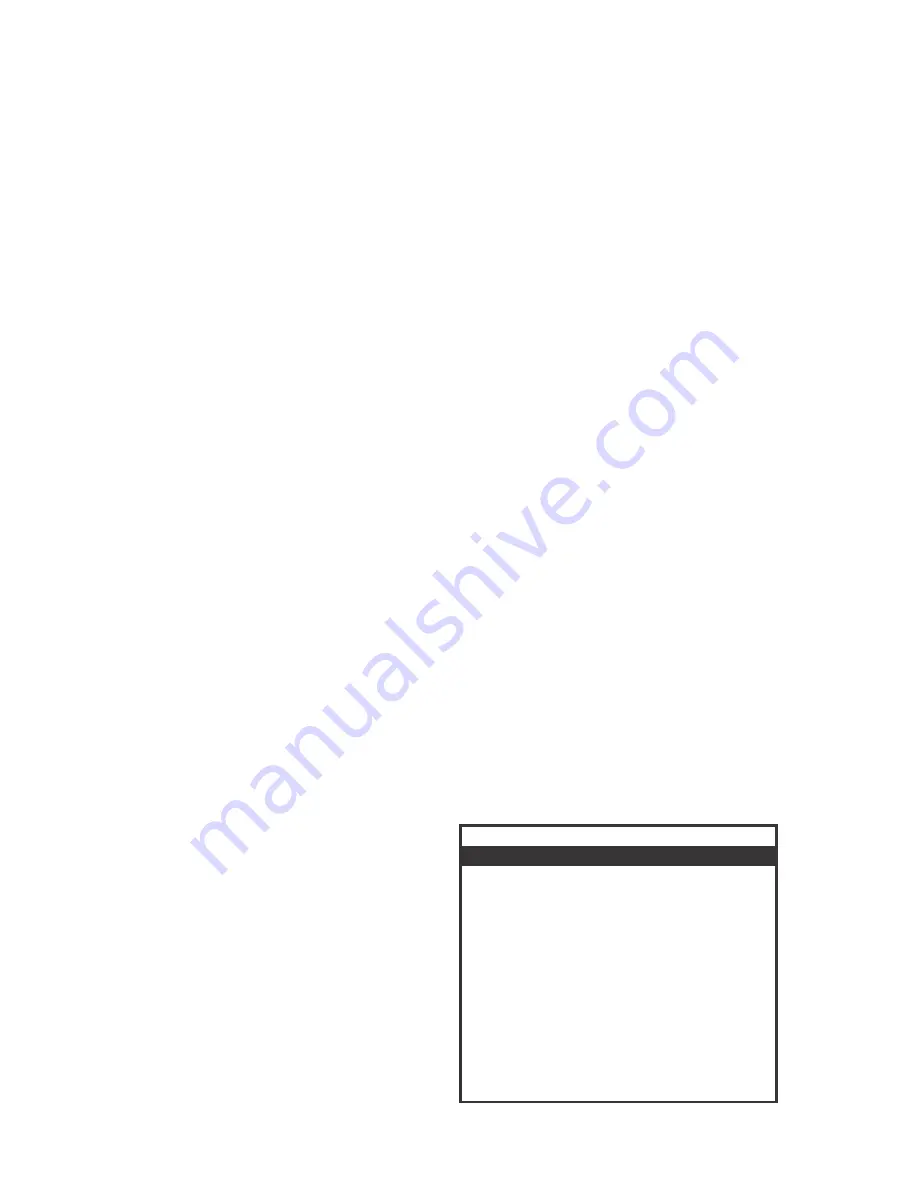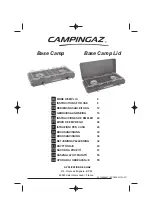
3
3. Close door. (Position damper and smokestack damper
approximately at one quarter open.) This burn should be
sustained for at least two hours, the longer the better.
Then, begin increasing temperature by opening the damper
and smokestack damper half-way and adding more
charcoal. Your smoker is now ready for use.
2. Build a small fire on the fire grate or pan, being sure not to
lay coals against the walls.
1. Brush all interior surfaces including grills and grates with
vegetable cooking oil.
Before cooking with your smoker, the following steps should
be closely followed to both cure the finish and season the
interior steel. Failure to properly follow these steps may
damage the finish and/or impart metallic flavors to your first
foods.
PREPARING TO USE YOUR SMOKER
Rust can appear on the inside of your smoker. Maintaining a
light coat of vegetable oil on interior surfaces will aid in the
protection of your unit. Exterior surfaces of smoker may need
occasional touch up. We recommend the use of a
commercially available black high temperature spray paint.
NEVER PAINT THE INTERIOR OF THE UNIT !
SMOKING AND SLOW COOKING
Remove the cooking grill from the firebox and build your fire on top
of the fire grate in the firebox. Either charcoal or wood may be
used, but wood is the recommended fuel for it’s rate of burn and
the flavor it imparts to the food being cooked. Most seasoned
hardwoods are good for smoking such as hickory, mesquite, pecan,
oak, and many other fruit woods. Bark should be avoided or
burned off first as it contains a high acid content and imparts an
acrid flavor.
SMOKING WITH WOOD CHIPS/WOOD CHUNKS
For a more robust smoke flavor while using charcoal briquettes or
lump charcoal, try adding wood chips or several wood chunks to
the fire. Wood chunks are available in a variety of natural flavors,
and can be used alone or in addition to charcoal. As a general
rule, any hardwood that bears a fruit or nut is suitable for cooking.
However, different woods have very different tastes. Experiment
with different woods to determine your personal favorite, and
always use well-seasoned wood. Green or fresh-cut wood can turn
food black, and tastes bitter.
Our Recommendations:
Chicken
- Alder, Apple, Hickory, Mesquite
Beef
- Hickory, Mesquite, Oak
Pork
- Fruitwoods, Hickory, Oak
Lamb
- Fruitwoods, Mesquite
Veal
- Fruitwoods, Grapevines
Seafood
- Alder, Mesquite
Vegetables
– Mesquite
After allowing the fire to burn down, close the doors and control the
temperature and smoke with the dampers located on the firebox
and atop the smokestack. Smoke is contained within the
chambers, which will reduce burn while imparting more smoke
flavor. Do not operate the Smoker with temperatures exceeding
450 degrees in the smoker chamber. Place the food in the smoker
chamber and monitor the temperature. Cooking and smoking are
taking place using indirect heat. There is no need to worry about a
grease fire flare-up ruining the food. Do not place food within 15cm
of the opening from the firebox into the smoker chamber. A general
rule of thumb for cooking is about 1 hour per pound for smoking
large cuts of meat. Refer to a cook book for specific cuts of meat.
Limit the number of times you open the smoker chamber door as
this will allow heat to escape and extend the cooking time.
Ground Meat
Beef, Pork, Veal, Lamb.............................71 °C (160 °F)
Turkey, Chicken........................................74 °C (165 °F)
Fresh Beef, Veal, Lamb
Medium Rare............................................63 °C (145 °F)
(let stand 3 minutes before cutting)
Medium...................................................71 °C (160 °F)
Well Done.................................................77 °C (170 °F)
Poultry
Chicken & Turkey, whole..........................74 °C (165 °F)
Poultry Parts.............................................74 °C (165 °F)
Duck & Goose...........................................74 °C (165 °F)
Fresh Pork
Medium Rare............................................63 °C (145 °F)
(let stand 3 minutes before cutting)
Medium....................................................71 °C (160 °F)
Well Done.................................................77 °C (170 °F)
Internal Cooking Temperatures
SMOKER MAINTENANCE
Frequency of clean up is determined by how often the grill is
used. Make sure coals are completely extinguished before
cleaning inside of the unit. Thoroughly rinse with water and
allow to air dry before using again. Wipe out the interior of the
unit with a cloth or paper towels.
When finished cooking, and the unit has adequately cooled,
clean out all remaining ashes. Ashes collect moisture, which
can lead to premature rusting and decay. Periodically coating
the interior surfaces with vegetable oil will aid in the
protection of your unit. Also, occasional touch up of the
exterior paint will be required. Black, high-temperature spray
paint is recommended. NEVER PAINT THE INTERIOR OF
THE UNIT.
Cooking Surface:
If a bristle brush is used to clean any of
the grill cooking surfaces, ensure no loose bristles remain on
cooking surfaces prior to grilling. It is not recommended to
clean cooking surfaces while grill is hot.
Building Your Fire
1. Stack charcoal briquettes or wood into a pyramid-shaped
pile on top of the charcoal grate or ash pan. We
recommend using 3 pounds (approximately 45 briquettes)
to start your fire, adding more as needed.
2. If using lighter fluid, saturate the charcoal briquettes with
lighter fluid and let it soak in for approximately 5 minutes. If
using a chimney starter, electric starter, or other type of fire
starter, light your fire according to the manufacturer's
instructions.
3.
Always light the fire with the grill lid open.
Leave lid open until briquettes are fully lit. Failure to do this
could trap fumes from charcoal lighter fluid in grill and may
result in a flash fire when lid is opened.
4. Never add charcoal lighter fluid to hot or warm coals as
flashbacks may occur causing injury.
5. You are ready to begin cooking when the pile of briquettes
ashes over and produces a red glow (approximately 12 –
15 minutes).
6. Depending on your cooking method, either leave the
briquettes in a pile or spread evenly across the charcoal
grate using a long-handled poker.
COOKING TIPS
Know When Your Fire is Ready
Successful charcoal grilling depends on a good fire. The
general rule for knowing when your coals are ready for grilling
is to make sure that 80 percent or more of the coals are ashy
gray. Using caution, arrange the hot coals on your charcoal
grate based on your desired method of cooking. Here are a
few steps you can take to adjust the temperature of your fire:
-If it is too hot, spread the coals out a bit more, which makes
the fire less intense.
-Raise or lower the adjustable charcoal grate.
-Partially close the vents in the grill, which reduces the
amount of oxygen that feeds the fire.
Know When Your Fire is Ready
(Continued)
-Use the indirect grilling method, with coals to either side of drip
pan and the food over the pan rather than directly over the coals.
-In the event of a severe flare-up, spray the flames with water from
a squirt bottle. Be careful, spraying with water tends to blow ashes
around and make a mess.
-Add briquettes 2 or 3 at a time to increase the burn time. Allow 10
minutes for coals to ash over before adding more.
GB






























